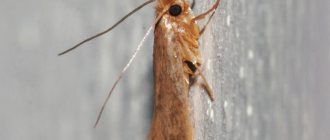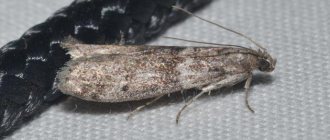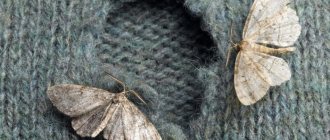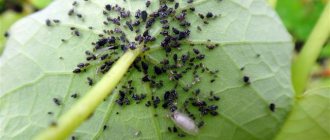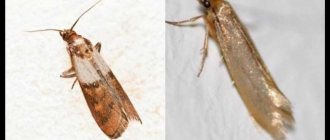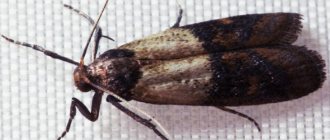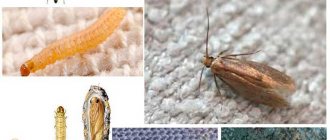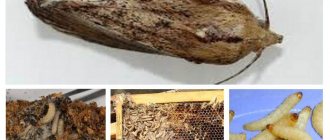Poplar moth (Lithocolletis populifoliella) is one of the varieties of nocturnal winged pests. Thanks to the bright pattern on its gray velvety wings, it is called the Pied. The period of distribution of the small insect occurs during the flowering of the poplar. Moths breed in the fluff and along with it end up on balconies, houses and apartments.
Moths do not damage clothes like other representatives of the species. It selects household appliances indoors, penetrates them and lays eggs, causing the devices to malfunction. Since there are few effective means to eliminate parasites, preventive methods are used.
Appearance of poplar moth.
Where does the poplar moth live?
There are many nocturnal inhabitants found in nature. This variety is most common in the Caucasus, in Central Asian countries (Kazakhstan, Uzbekistan, Kyrgyzstan, Turkmenistan, Tajikistan) and in European Russia.
The parasite prefers regions where balsam, pyramidal, sweet-scented and laurel-leaved poplar grow, and avoids areas with black and Canadian poplars. Leaves wild forests unattended.
On the South American continent there is a large subspecies with a wingspan of 7 cm and above.
Habitat of the poplar moth.
Thanks to their coloring, insects are invisible during the daytime. In the evening, they gather in the light of lanterns, cover the ceiling, fly into open windows, into entrances, and land on people.
Unwanted guests do not allow the home to be ventilated. Colonies of the moth quickly fill electrical appliances, chandeliers and lampshades.
White fluff is a favorable environment for the parasite to reproduce. The summer heat protects against the growth of pest numbers. Cool summers and warm winters, on the contrary, contribute to an increase in the population and lead to sharp surges in numbers and invasions.
How to fight kitchen moths?
First of all, you need to examine the contents of all containers (even bags) in which “groceries” are stored. After this, all that remains is to make a choice: throw away all spoiled food so that the pest does not “escape” along the way, or destroy the moth by heating (for example, in a microwave), or send the food to the freezer for a while.
The cabinets need to be wiped with vinegar, not leaving even the smallest crack unattended. Then leave the doors open so that everything is well ventilated. Moths do not like fresh air. This kind of sanitation will take more than one day.
There is another option. These are traps designed for food moths, for example, “Raptor” and “Aeroxon”.
The smell of garlic and some spices (allspice, cloves, bay leaves, etc.) repel moths. Traditional means of fighting moths include orange (slightly weaker lemon) peels, pine needles, pyrethrum and newspapers with fresh printing ink.
In the kitchen (and in the rooms) it is useful to keep fragrant geranium (pelargonium) and plectranthus. It is this plant with a strong smell of crushed leaves that is popularly called “moth tree”.
And most importantly, you must buy only fresh products and not keep them in a warm room for a long time. If we purchase products for long-term storage, we make sure to place them in the cold.
What does it look like
The name “poplar moth” is considered conditional. Entomologists classify the insect as a subspecies of the Butterfly family. Because of the characteristic marks that the small pest leaves on the foliage, it is called a leaf miner.
Moths are distinguished by narrow, blade-shaped wings edged with fringe. The front pair is brown with small white and brown contrasting inclusions, the back pair is shorter, steel color. The wingspan of an adult insect (imago) is 6-10 mm, the average length is 5-8 mm. Such colors and sizes make the moth invisible against the background of trees.
Cocoons hide in cracks and crevices of houses, bark, hollows, fall into the ground with fallen leaves and continue to live after wintering. At the end of spring, harmful insects fly out and actively mate.
Photo of an adult moth.
Description
Poplar moth (moth) is a nocturnal pest that appears during the active flowering of poplar. It is a small winged insect belonging to a subspecies of butterflies; it can easily enter the house through absolutely any crack or opening.
It is as light as poplar fluff, and with it it can travel long distances.
The poplar moth looks like a small moth. How to recognize it? You need to take a close look at her front wings. They have a clearly visible variegated speckled pattern and a velvety edging – this is the distinguishing feature of the insect. The hind wings of the pest are characterized by a calm steel color. This unusual color allows the poplar moth to be invisible to its enemies.
The wings of an adult reach a length of 7 to 8 mm, with a wingspan of 11 mm. The poplar moth reproduces by laying larvae, which are characterized by a bright yellow color, but gradually, as the insect matures, it becomes bright orange. Poplar moth larvae overwinter in the ground.
During the day, the moth is in the trees, hiding from the sun and other insects and birds, but at night it begins to become active. Adults do not feed: the energy they received while still in the cocoon is quite enough for them.
The most dangerous and voracious are the poplar moth larvae. During the day, the larva feasts on the sweet sap of trees, and at night begins to destroy the leaves. Her diet includes poplar, apple, plum, and pear foliage.
The life of this pest is short and lasts only 72 hours. But even in such a short period of time, an adult, capable of reproducing, lays several thousand eggs, from which larvae hatch after 10 days.
By mid-June, the larvae enter the pupal stage, and after about a month, a full-fledged moth emerges from the cocoon.
How to recognize an insect
The greatest damage from the pest occurs in urban green spaces. The main food is poplar, but the parasite does not ignore other plants.
You can recognize an insect by its characteristic features, including:
- Leaf fall. Moth colonies eat the foliage, causing it to fall prematurely and the branches to freeze. In such cases, many trees die.
- Moves of different configurations. Depending on the type of tree or plant variety, the pestle makes pinpoint punctures, bizarre passages of white and yellowish colors, and grinds off the entire surface.
- Through holes in young leaves (mines). The caterpillars choose a place for pupation in fresh greenery, eating large holes with a diameter of 1.5-2 cm.
- Spots on the crown. Damaged plates quickly turn yellow, fade and fall off.
Poplar leaves damaged by moths.
Old trees are more difficult to tolerate pest invasions.
Folk remedies
Before using harmful chemicals, you should try to remove insects from your home using safe methods - traditional ones. You need to study the methods in advance, choosing the one that suits you. It is worth remembering that folk remedies will not kill, but will only scare away the pest, so they must be used in combination with mechanical methods (for example, using a vacuum cleaner).
Various plants and herbs have a depressing effect on pestra. You can make a wreath or broom from the following plants:
- sagebrush;
- tansy;
- lavender;
- rosemary;
- mandarin.
Herbs can be put in fabric bags and scattered around the apartment. If there are too many moths, this method will not help.
Poplar moths do not like the smell of cedar essential oil, so it is used to make home remedies
The smells of essential oils - cedar, wormwood, eucalyptus, tea tree - have a deterrent effect. They can fill the phytobarrier and place it in the place of greatest concentration of moths. The capacity needs to be renewed every month. This will not only get rid of poplar moths, but will also give the room a pleasant aroma. You can place dry lavender branches, strawberry-scented soap, and orange peels in dark places.
Previously, housewives made pestra cubes, laying them out throughout the apartment.
To prepare them you will need:
- a few drops of lemon oil;
- detailed cedar bark - 115 g;
- myrrh - 115 g;
- cinnamon - 115 g;
- soap powder - 35 g;
- a few drops of alcohol;
- ground black pepper - 115 g.
The ingredients are mixed, alcohol is added until a sticky mass is formed. The resulting composition is used to make cubes that are laid out behind curtains, near windows, and household appliances.
An easier way to prepare cubes is to take 500 g of alabaster, add 50 g of ground black pepper, and pour in 40 g of naphthalene. Alcohol is added to the mixture until a ball is formed. They are scattered throughout the housing.
A sachet against moths gives an excellent effect. To make it, you will need to take 500 g of lavender, 1.9 kg of camphor, 30 ml of lavender ether. They are mixed, finely chopped and placed in boxes or bags.
You can make paper with an insect repellent scent.
To do this you need to mix:
- 25 g camphor;
- 15 ml cedar oil;
- 25 g phenol;
- 350 ml gasoline or kerosene.
When preparing the mixture, you must follow safety precautions, as it is flammable. Some components are harmful to pets, so it is better to give your pets someone to look after during the procedure.
If pestra is noticed on indoor plants, they need to be treated. You can use a solution of laundry soap. Pieces of soap with the scent of citrus, mignonette, and lily of the valley can be placed in places where moths are spotted.
The insect does not like the smell of cedar, lavender and cloves, lemon, orange. If you buy flavors with these aromas, there will be significantly fewer individuals. You can soak tampons with essential oils of plants and place them in inconspicuous places in your apartment. Instead of orange essential oil, you can use fresh fruit peels. As they dry out, about once a month, they will need to be replaced with new ones.
Indoor plants will help drive away moths. Insects cannot stand proximity to geraniums, tobacco and nettles, so it is advisable to place them on windowsills. The smell of leaves will scare away unexpected guests - pests will not be able to enter the home through the windows.
Tobacco in a fabric bag is another effective means of repelling poplar moths. It needs to be laid out on the window sills and on the floor. Having sensed a pungent odor, insects will not stay in the apartment for long.
Dried chestnut fruits will also help you forget about the unpleasant problem. They are laid out in places where moths are spotted.
Important! When using folk remedies, you need to remember that they help scare off adult moths; you will need to get rid of the larvae using more radical methods.
Stages of reproduction
One complete phase of the poplar moth life cycle is 2-3 months:
- Mating occurs in mid-spring.
- In May, the female lays alternately up to 32 eggs on the underside of last year's leaf. The eggs are oval in shape, flattened at the edges, covered with the secretion of the gonads. They have a rough texture, matte, with a diameter of 0.2-0.3 mm.
- In 1-1.5 weeks, larvae form, which climb into the leaf plate and are covered with a thin film. At this stage of development, they vigorously eat greens, accumulating the necessary nutrients.
- After 2-3 days, young caterpillars 3-5 mm long hatch. The shape of their body is transformed 5 times - from legless and pale, the caterpillar turns first into white, then into lemon with 2 pairs of legs. Eats only fiber.
- A loose cocoon of cobwebs forms in the through hole. The development stage lasts from a week to 10 days. The sharp cocoon of a light brown hue reaches 4-5 mm in length.
- From late July to early autumn, the pupae turn into butterflies and live for 3 days.
Stages of moth reproduction.
Each adult strives to lay as many eggs as possible. Suitable places for breeding are bags of flour, cereals and dried fruits.
Life cycle
During the warm season, a female poplar hawk moth can bring one or two broods. Therefore, adult individuals can be found from May to September inclusive. Adults do not feed at all. The insect overwinters, as a rule, in the pupal stage, which causes the earlier appearance of adult individuals in the spring months.
The insect egg is quite large, spherical, pale green in color, glossy, clearly visible to the naked eye. Females lay eggs individually or in pairs on the undersides of the leaves of the host plant. In total, females lay up to 200 eggs throughout their life.
In the first stage of life, immediately after hatching, the larvae are pale green in color with small yellow tubercles and a creamy, clearly visible horny formation on the back of the body. As the hawkmoth caterpillar matures, it develops yellow diagonal stripes on its sides and pink spiracles. Insects parasitizing on willow can get quite variegated colors with an advantage of red shades.
On poplars, the larvae are more bluish-white with cream stripes and tubercles. Hawkmoth caterpillars are quite strong and large, growing up to 65-85 mm in length. Before pupation, the larva falls to the ground and burrows into the ground to a depth of 2-3 cm, close to its host plant. After 3-10 days, an adult insect is born. This variable period is due to environmental conditions, mainly temperature and soil moisture.
Adults are active exclusively at night, most active in the second half of the night. During the daytime, the hawk moth falls asleep and completely loses activity - if you find it sleeping on the wall of a house, you can freely pick it up, the insect will not even show concern. As noted above, adult butterflies do not feed at all - the sucking mouthparts in the form of a proboscis, which is characteristic of all representatives of the family, are almost completely reduced.
What does it eat?
The main source of food for the insect is poplar. Caterpillars eat green foliage, and adults find food in the tree trunk. In the cold season, they make do with fallen poplar leaves and linden bark.
In addition, the moth also likes to profit from other plants, these are:
- fruit bushes and trees (pears, apple trees);
- hardwoods (aspen, maple and linden);
- flowers (rhododendron, roses, violets and chrysanthemums);
- greens (lettuce);
- vegetables (cucumbers, etc.).
The moth eats each green space in different ways:
- intersecting paths remain on the crown of apple trees;
- brown burrows appear on pear trees;
- rhododendron foliage is completely eaten;
- through dots and curly patterns are visible on the rose bush;
- cucumber and violet plates are distinguished by narrow paths with whitish dots.
Signs of plant damage
The main sign of moth presence on fruit trees and other plants is the formation of pits on the leaves:
- On the leaves of the apple tree it is a serpentine or round shape;
- Beige and brown burrows are visible on pear leaves;
- The leaves of roses have small holes and zigzag passages;
- Violets and lettuce have bright dots and passages;
- The leaves of the chrysanthemum have light zigzag strokes;
- The cucumber leaves will be gnawed with white dots.
Therefore, as soon as you notice signs of the presence of moths, you must immediately begin to fight it.
Do poplar moths bite?
The moth cannot bite a person; it can only cause psychological inconvenience and disrupt the cozy and comfortable atmosphere of a house or apartment.
Is it dangerous for humans?
The parasite is not dangerous to human life or pets.
Poplar moth is absolutely safe for humans.
Poplar moth, unlike rodents (rats, mice) and some insects (lice, mosquitoes, flies, bedbugs), is not a carrier of severe infectious diseases, and therefore does not harm health.
Having flown into a room, moths do not spoil clothes and food, but leave marks that are difficult to remove on furniture and home textiles.
Electrical installations, equipment and lighting fixtures suffer from moth infestations. Insects flock to the light, get into chandeliers and lampshades, and lay eggs in equipment, damaging and dirtying it.
The presence of uninvited guests in the house irritates the owners, so all available methods of control are used.
Preventing moths
To avoid encountering the problem again, just follow simple rules:
- Housing needs to be cleaned regularly and things need to be taken care of.
- It is better to throw away clothes that are not worn for a long time.
- Every year you need to check the condition of pillows and blankets. They can be treated with a steam iron and ventilated in the air.
- Moths are attracted to greasy stains. Before summer, seasonal items should be washed, steamed, or dry-cleaned to reduce the likelihood of insects appearing.
- After washing, it is advisable to put things in vacuum bags.
- Bulk products are best stored in airtight containers. You can't leave leftover food in sight - you need to put it in the refrigerator.
- Moths prefer high humidity and lack of ventilation, so the apartment must be regularly ventilated.
- Insects do not like bright light - it is desirable that the apartment be bright.
- Having noticed that moths appear in the apartment every year, tablets, sections, and briquettes should be used as preventive measures.
In the fight against poplar moths, the same measures are used as against mosquitoes and flies. If independent attempts to get rid of it are unsuccessful, you should turn to professionals. Experts eliminate moths not locally, but with the help of a water suspension that penetrates into hard-to-reach corners of the apartment. This ensures complete destruction of pests.
Source
Ways to fight in an apartment
The main rule for effective control of harmful insects is that all steps are taken before the poplar begins to bloom.
In the event of pest penetration into a home, before choosing a method of destruction, it is necessary to determine the stage of its development.
To combat this species, there is no drug that can simultaneously cope with both larvae and adults.
You can fight moths or prevent their appearance in your apartment in the following ways:
- Installing a mosquito net with small mesh on the windows (if not available, use gauze). Such a barrier protects the room if there is a danger of an adult insect entering it.
- Use of fumigators. Small and economical electrical appliances operate from the mains, electricity consumption is only 3-5 W/day. The device is refilled with modern insecticides that are harmless to people and animals in liquid form or in the form of plates.
- Clutches of eggs have to be destroyed in cracks and holes using a vacuum cleaner.
- The use of insecticidal preparations in the form of sprays and aerosols against adult moths. Such means kill both flying and crawling individuals. After spraying, wet cleaning and airing of the room are indicated.
- An effective method of control is to install glue traps, which the insect is afraid of.
With the first frost, the pests die. Next season, it is recommended to use preventive measures to prevent mass invasions. Since mid-spring, municipal institutions have been carrying out special treatment of plantings.
Types of funds
It is impossible to achieve complete disappearance of the pest in one go. Many areas are addressing the problem ahead of time. In the fall, fallen leaves are destroyed, and in the spring, the crowns, trunks and tree trunk areas are sprayed with chemical compounds.
It is recommended to choose poisons with caution.
Urban landscaping uses plants that attract natural moth regulators. Entomophages eat up to 60% of moths.
In addition to preventive measures, the following chemicals and poisons are effective in combating the poplar moth population in urban environments and garden plots:
- Numerous clutches of eggs and caterpillars are destroyed by compounds that contain paraffin or karbofos. The drugs are ineffective in removing adult moths. Toxic substances can damage other crops; the proportions specified in the instructions must be strictly observed.
- Safe insecticidal mixtures of pyrethrum (Caucasian chamomile) in liquid or powder form are used against caterpillars and butterflies. A fast-acting composition without a strong odor has a paralyzing effect. Diluted and applied in the morning or evening up to 7 times per season, with breaks of 4-6 days. To destroy the pupae, the solution is poured into the ground.
Tree processing.
Since insects quickly adapt, are highly resistant to many poisons and are not afraid of pesticides, it is recommended to alternate drugs or combine them.
With numerous outbreaks, the number of miners is reduced in a radical way - poplars are cut down and other tree species are planted.
Traditional methods
Experienced gardeners and summer residents use the following methods to kill moths:
- cleaning infected trees with strong water pressure - acts as a deterrent, helps get rid of a large number of individuals, and interferes with reproduction;
- boards with glue or special baits from a specialty store;
- settlement of ichneumon beetles on the site, in the greenhouse, eating imagoes and oviposition;
- inspection of plants and mechanical removal of damaged leaves;
- to prevent reproduction, low-growing crops (flowers and cucumbers) are covered with non-woven fabric;
- oil of spring crops applied to the foliage can repel the pest.
The insect will not disappear completely. The methods are effective for reducing the number in the current period.
Destruction of butterflies on the street
The following are considered environmentally friendly methods of controlling poplar moths used outdoors:
- autumn destruction of old fallen leaves;
- attracting entomophages (riding beetles) to the site, used as food for adult moths, larvae and egg-laying moths;
- inspection and manual removal of infected leaves;
Poplar moth larva. - the use of special sticky traps;
- flush;
- using spring plant oil to repel insects;
- the use of non-woven material to cover low-growing crops (cucumbers and flowers) in order to prevent reproduction;
- sanitary pruning of tree crowns;
- replacing poplars with trees that are unattractive to this pest.
In some cases, the use of chemicals cannot be avoided:
- Spraying the trunk, crown, and tree trunk area with pesticides (karbofos). It is aimed at destroying larvae; this toxic substance has no effect on adults and pupae. Compliance with safety precautions is considered a prerequisite for the use of toxic substances.
- The use of paraffin-based products that have a negative effect not only on moth larvae, but also on moth eggs.
- The use of ecological preparations made from plant raw materials - pyrethrum (from Dalmatian chamomile). Affected trees require weekly treatment.
When poplars are massively infected with variegated grass, they are completely cut down.
Where to go for help
Spotted grass is a dangerous pest along with ticks and bark beetles. Parasitizing urban green spaces and garden crops, it causes premature leaf fall and impairs the viability of trees.
Citizens complain to various authorities. To clear a large number of plants on which the pest lives, it is recommended to draw up collective letters of complaints to the territorial prefectures from residents of the block or entrance.
Based on the application, the city authorities assign special groups that assess the condition of the trees. Based on the results of the inspection, utility services treat plants with insecticides, cut off affected branches, or cut down poplar groves and plant new varieties.

